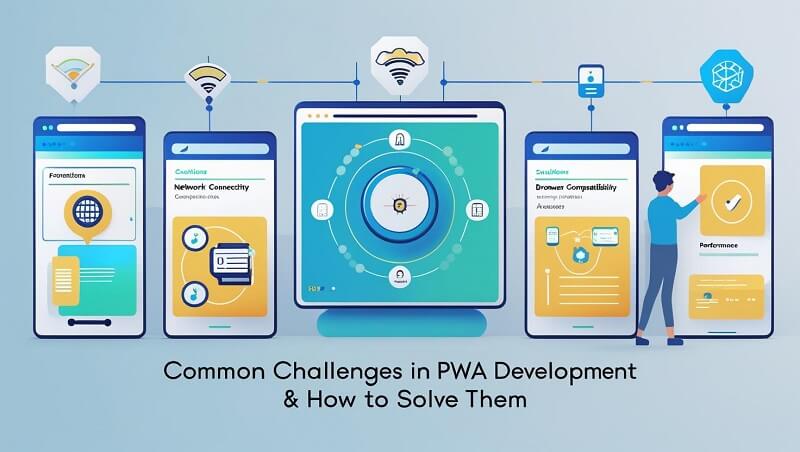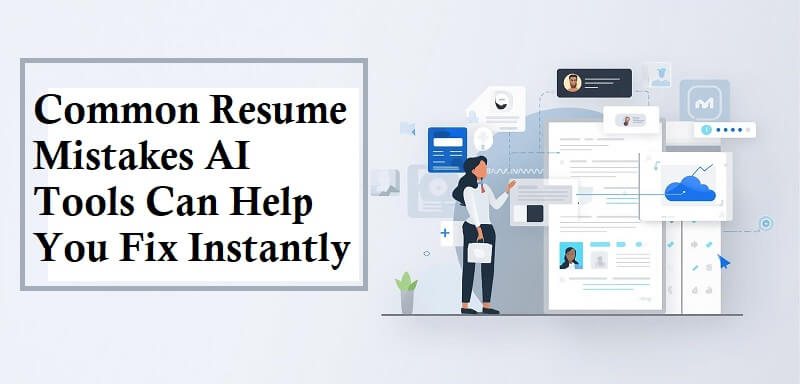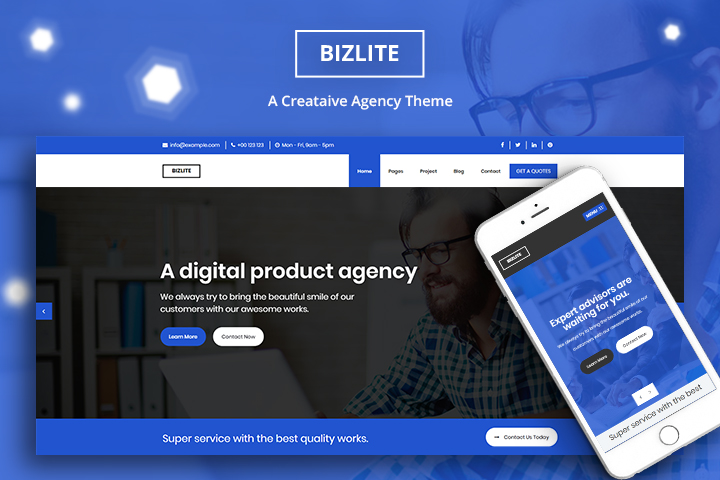Navigating the Challenges in PWA Development
Progressive Web Apps (PWAs) are revolutionizing the way we design mobile and web experiences. They bring the two worlds together—the speed, responsiveness, and installability of native apps and the reach and flexibility of the web. From enhanced performance to offline capabilities, PWAs have gained popularity rapidly among developers, startups, and large companies.
But building and maintaining a successful PWA isn’t always easy sailing. With the technology constantly evolving, the developers must face a very unique set of technical and strategic challenges. In this blog, we’ll be discussing some of the most common obstacles in PWA development and sharing real-life solutions so that you can overcome them easily, if you’re building your first PWA or scaling an already established one.

What are Progressive Web Apps?
Progressive Web Apps (PWAs) are web applications that use modern web technologies to deliver fast, reliable, and engaging user experiences similar to native mobile apps. They accept the support of offline access, push notifications, background syncs, and home screen installation, but securely do this by using HTTPS. The PWAs are flexible as they are designed to be responsive, and operate across browsers and devices without a drift. This makes it an excellent decision in regard to both businesses as well as developers.
PWA development is aimed at developing applications that integrate the features of web and mobile applications. It involves exploiting service workers, manifest files, and responsive UI patterns in order to build an app-like experience with a smooth feel. However, developers often encounter challenges in PWA development related to browser compatibility, offline functionality, and performance optimization, requiring thoughtful architecture and consistent testing across platforms.
Top Challenges in PWA Development With Solutions
Although PWAs integrate both features of a native app and websites, developing them cannot be achieved without challenges. Programmers have to deal with all kinds of browser incompatibilities, technical constraints, and user-friendliness problems. Being aware of these problems is key when preparing a reliable and scalable product at its initial stage of creation. Below, we explore the most common challenges in PWA development and how to effectively resolve them.
- Inconsistent Browser and Platform Support
One of the most notable challenges in PWA development is the uneven implementation of features across different browsers, particularly on iOS. While Android fully supports all of its capabilities, including using push notifications and background sync, iOS restricts or does not support core capabilities.
Solution:
Adhere to progressive enhancement by having a solid baseline experience in the first place and adding augmented features only where deployed. Cross-browser testing using tools like BrowserStack ensures higher compatibility.
- Offline Functionality Complexity
Offline availability is a highlight aspect, but also one of the most difficult hurdles in building a PWA. Service workers, caching strategies, and the fallback content all require complex technical planning.
Solution:
Leverage libraries like Workbox.js to simplify service worker setup. Put static information in cache-first and dynamic information on the network-first. Keep the cache’s versioned to avoid conflicts.
- SEO and Discoverability Issues
Client-side rendering used in PWAs that are created as Single Page Applications results in poor SEO visibility of the page. This contributes to discoverability-related challenges in PWA development that can limit organic reach.
Solution:
Implement Server-Side Rendering (SSR) or Static Site Generation (SSG) with frameworks like Next.js or Nuxt.js. Use semantic HTML and submit XML sitemaps to improve indexing.
- Performance Bottlenecks
Although this is the motivation of PWAs, their functionality level can be slowed down by over-bloated scripts or unoptimized files. This is one of the more common challenges in PWA development that directly affects user satisfaction.
Solution:
Optimize using lazy loading, code splitting, and compression techniques. Undertake frequent auditing using such tools as Lighthouse to ensure high scores in performance.
- Push Notification Constraints
Push notifications are more in demand to increase engagement, but they are not reliable across all platforms, especially iOS. The fragmented support generates communication-related issues in PWA development.
Solution:
Design fallback mechanisms, such as in-app or email notifications. Use segmented targeting and vary opt-in flows so that adoption is high on the platforms.
- Security and HTTPS Requirements
Service workers need a secure HTTPS environment. Configuring this can be one of the more technical tasks in PWA development, especially for small teams that are new to web security protocols.
Solution:
Use free SSL tools like Let’s Encrypt. Use strong Content Security Policies (CSPs) and regularly scan your codebase to ensure data integrity and trust from users.
- Limited Access to Native Hardware Features
PWAs have no full access to hardware-specific features like Bluetooth, fingerprint readers, or file systems, which pose functional challenges to PWA development in applications involving healthcare or the IoT.
Solution:
Explore browser-supported Web APIs (e.g., Web NFC, Web Bluetooth). When it comes to the hardware-intensive apps, you might want to use the hybrid wrappers such as Capacitor or Electron and fill in the gap.
- App-Like UX/UI Consistency
Another silent but significant difficulty of the PWA development is preparing a coherent app-like experience on all devices. It is difficult to tie the touch gestures, transitioning, and native-like layouts to one hundred percent nailing them down.
Solution:
Choose universal development frameworks, such as React or Vue, in combination with mobile-first design systems. Libraries of animation, such as GSAP or Framer Motion, can make the mimicking of the native transitions more efficient.
- Versioning and Update Visibility
This might be an opportunity to serve stale content on PWAs because of over-aggressive caching. This leads to frustrating challenges in PWA development when users unknowingly access old versions of your app.
Solution:
Manage service worker updates using skipWaiting() and clients.claim(). Warning users when newer updates are out and inviting them to update their browser with the recent experience.
- Testing and Debugging Complexity
PWAs work across various environments—mobile and desktop, online and offline, installed and browser-based. The lack of consistency in testing makes extensive functionality exhaustive to test, contributing to the practical difficulties of PWA development, particularly in iterative updates.
Solution:
Utilize powerful testing tools such as Lighthouse, Puppeteer, and BrowserStack to mimic different conditions, such as offline usage and responsiveness of devices. Have automated tests for service workers, caching mechanisms, and network requests to identify potential problems in an early stage and provide an equivalent experience on all devices. Pair these with Static application security testing tool so that functional tests catch regressions while static analysis surfaces security issues in the code itself.
Future of PWA Development
As the web continues to evolve, Progressive Web Apps will increasingly be a part of cross-platform development in the future. With improved browser support, more stringent standards of performance, and more focus on user experience, PWAs are set to be a mass market solution for businesses seeking cost-effective and scalable alternatives to native applications. As part of modern IT management solutions, PWAs offer businesses a cost-effective and scalable alternative to native applications, especially with improved browser support, more stringent standards.
New technologies like WebAssembly, more recent Web APIs (e.g., Web Bluetooth, WebXR), and better mobile operating system integration will further close the gap between native and web experiences. Concomitantly, solutions to long-standing problems in PWA development—service worker debugging, access to hardware, and offline testing—are changing quickly as well. As these tools and standards develop further, developers will be able to build PWAs that are fast, secure, and native-appearing.
In the coming years, we will witness PWAs’ dominance in industries (such as e-commerce, SaaS, news publications, and emerging markets) due to their performance, flexibility, and minimal installation barriers. The future of PWA development is promising, enabling companies to offer stable digital experiences across devices, networks, and user types.
Wrapping Up
Progressive Web Apps are not just a future invention; it is something effective that is available now to deliver a smooth, fast, and captivating online experience. Admittedly, some of the pitfalls of PWA development are overwhelming; these are platform inconsistencies or offline concerns, but they are not exactly insurmountable. Through the correct usage of tools, frameworks, and strategy of development strategies, companies and programmers will be able to use these obstacles as an innovation and growth platform. Once PWAs continue to evolve as the fields develop and grow around them and web standards, it is best that we start investing in the knowledge to learn to develop them. Whether you are developing a new product or optimizing an old one, overcoming the issues in PWA development will enable you to craft high-performance apps that meet user demands on any device and environment.








